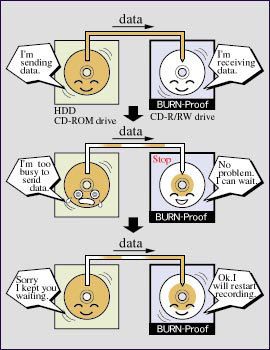Eleven 20x/24x CD Burners
Anti-Buffer Underrun Technologies

The first anti-buffer underrun technology, Buffer Under Run-Proof (hence Burn-Proof), was developed by Sanyo. Buffer underrun errors occur when the PC doesn't have enough resources to send an uninterrupted dataflow to the burner cache. Since the dataflow from the buffer to the write head should be continuous, this may cause the burning operation to fail. To avoid this kind of problem, manufacturers began by increasing the cache size to 4 MB. But this implied two things: that the PC running the burner had to be powerful enough; and that it did nothing else in the meantime so as not to hinder the dataflow. Now, the trouble is that most users want to be able to use their PC while CD burning is in progress, so the next step is to make CD burning a transparent task.

To understand the value of technologies like Burn-Proof, we first need to know the function of the cache memory on a burner. Recent burners either use the P-CAV or the Z-CLV modes. As soon as recording starts, the data must reach the burner a little faster than the real write speed. For writing in 16x, the burner needs a transfer rate of about 2.8 MB/s. The multiplication is as follows: 2352 x 75 x 12. A block equals 2352 Bytes; a second means 75 blocks; and the whole has to be multiplied by 12, because of the speed. To prevent the burning operation from depending entirely on the capacity of the IDE bus to send data regularly at this speed, burners have a cache memory to receive the data before sending it to the write head. This helps to adjust and counterbalance variations in PC resource availability. With a conventional burner, if the PC pauses a few seconds, the cache will be emptied and the burning operation will fail (16x = 2400 kB/s, meaning a second and a half of instability is enough to create a buffer underrun error). Burn-Proof and similar systems prevent this from happening by stopping the burning process when data no longer reaches the cache, and then starting the process in the same place when there are enough resources again. This prevents spoiling blank media and is very practical for making high-speed, CD-to-CD copies. Many CD players don't run faster than 16x to begin with, so technologies like Burn-Proof help to counter this weakness and run fast copying. This is also true when copying CDs which have been badly recorded, deliberately or not. You know what I mean.

In theory, the quality of a CD-R recorded with anti-buffer underrun technology is the same as one recorded normally. But there may be a gap at the point where burning stopped and started again, though this can't ever be more than 45 µm with Burn-Proof 1.0 and no more than 1 µm with the newly-revised version, a negligible amount with no effect on legibility. Note that the Orange Book allows a gap of up to 100 µm, so this leaves more than enough leeway for a burner to create a CD-R of compatible standard. Yet it is here that manufacturers enter the battle to defend their respective technologies. Yamaha, which developed Safe Burn with Oak Technologies, and Ricoh with its Just Link, claim that theirs have no gap at all, unlike the Sanyo Burn-Proof. In practice, you can't tell this from the amount of C1 errors (the most usual and visible) on a CD-R, so the size of the gaps is of scant importance when estimating the relative value of the technologies.
Stay On the Cutting Edge: Get the Tom's Hardware Newsletter
Join the experts who read Tom's Hardware for the inside track on enthusiast PC tech news — and have for over 25 years. We'll send breaking news and in-depth reviews of CPUs, GPUs, AI, maker hardware and more straight to your inbox.
Most Popular



